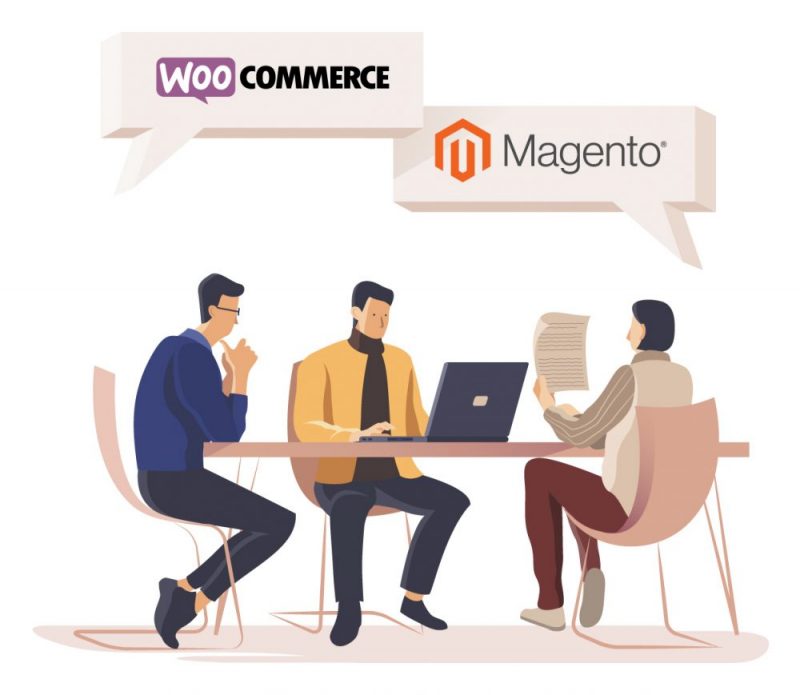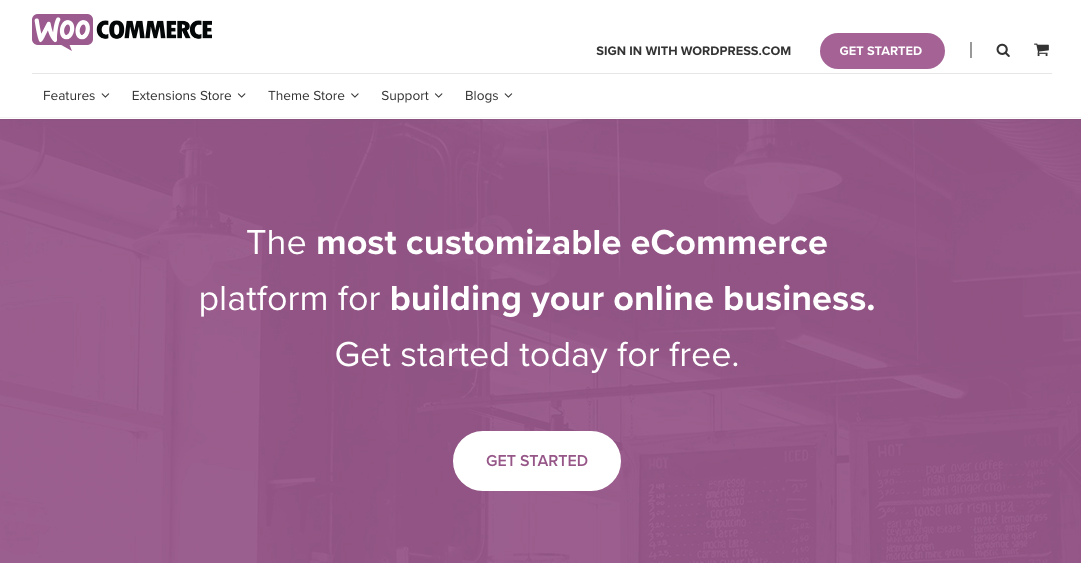Web entrepreneurs have a wealth of ecommerce platforms to choose from when they’re ready to open shop, but two of the biggest standouts are WooCommerce vs. Magento.
On the surface, both look very similar. They each offer the ability to list and sell physical and digital products. Both have an active community of developers that are constantly adding to and extending the platforms. But when one looks more closely, they will find that there are key differences for an emerging entrepreneur to know before committing to one or the other.

Take analytics as an example. Both support tools to gain customer insights and optimise their campaigns. On WooCommerce, these are premium add ons that will eat non-zero share of an early business’ budget. Magento, on the other hand, offers these tools right out of the box.
This isn’t a clear cut competition however. For Magento’s additional functionalities, it’s comparatively more difficult than WooCommerce. You may save yourself some cash by going with Magento, but you may pay with your time getting acquainted with a more robust but less user-friendly platform than WooCommerce.
While similar, these platforms are not without their differences and you’ll want to know what you’re getting into before you commit to one or the other. In this article we’ll cover this comparison thoroughly by:
- Explaining what both platforms are
- Giving an honest assessment of advantages and disadvantages
- Offering our expert on opinion on why you’d want one over the other
- Give you a starting point from which to make your own choice on the two
Let’s get started.
What is Magento?
In the simplest of terms, Magento is a web platform to sell your wares, physical and digital, online. If you want to build a simple, easy to use web interface for your customers to shop for and purchase your goods, Magento is a great place to start. This is a platform that enables you to showcase your offerings to customers on a desktop or mobile device.
Magento has two offerings: a free version for smaller retailers, and a premium version for larger scale users.
Formerly “Magento Community Edition,” Magento Open Source is a free web platform used by thousands of retailers and supported by a robust network of developers as well as an extension store where you can get additional functionality from the program (though that may not be free). If you’re just starting out as an entrepreneur, this is a great place to start.
Magento’s Enterprise edition, the bigger brother to Magento Open Source, has a number of differences with its free siblings, not the least of which is its price. This version of Magento will cost you about $15,000 per year.
What you’re getting for that price is a more extensive e-commerce product than the free version. For one, Magento Open Source is going to be a bit slower than the paid version in reindexing your products should you make a change in how you’re organising your products. Quite a bit slower. Magento Enterprise is reportedly 80 percent faster in rebuilding your catalog when you make a change in your product organisation. That might not matter if you have 40 products, but it could be a game changer when you have 40,000 products.
Magento Enterprise is also generally faster to load your store’s page compared to the free edition. The premium edition has a range of other advantages over Magento Open Source, including an option for one-step checkout, greater security for credit card purchases and the ability to undo changes to your products or database should you make a mistake on your Magento store.
All that said, unless you’re serving something in the range of 50,000 unique visitors per month, the free version ought to do everything you need.
Key Features
- Looks great on desktop or mobile platforms
- Backed by a network of programmers
- Has an app store for added functionality
- Offers a premium version to scale your enterprise easily
- A comparatively stronger product management ecosystem
- Strong ability to handle large volumes of web traffic (with Magento Enterprise)
Examples of Magento in Action

Morphie is the first battery case to be certified by Apple for use on their iPhones. It also happens to be sold from a Magento store. The California-based retailer sells in over 130 countries. It serves its customers from an elegant, sophisticated website that has helped it become the number one ranked battery case retailer worldwide.

You may know Land Rover as the premier seller of prestige four-wheel vehicles. But did you know they also have a store where they sell jackets and other products consistent with its unique brand? Those sales are handled through a Magento store.

Since WooCommerce is also free, the most salient pro in the Magento column seems to be the robustness of its features. While the learning curve is a bit steeper here, an entrepreneur who makes him or herself a student of Magento will be rewarded with a comparatively more powerful admin interface. On the client side, Magento is lauded for its ability to execute cross sales and upsales through its product search function.
These functionality differences are only more pronounced and leave Magento in even more favorable standing when considering the premium edition.
But that’s of course if you have the $15,000 per year for Magento Enterprise and whether you have the volume to justify that, so this is indisputably a con for this option. Also, Magento will require more work to set up and maintain than WooCommerce. While both products are listed as free, Magento may require you to pay with more of your time than another e-commerce platform.

What is WooCommerce?
WooCommerce is a WordPress plugin that turns the blog platform into an e-commerce venue.
You have to secure your own domain and hosting, but WooCommerce itself is free. And it’s quite easy to install. A few clicks and viola: you’re ready to sell your company’s product, book appointments or even take membership fees from your WooCommerce store.
The platform is elegantly designed and delivers a comfortable, user-friendly experiences for potential customers and clients who visit your WooCommerce store. For those administering one, WooCommerce endows entrepreneurs with the ability to tailor their product listings and store appearance with ease. Need anything you don’t see in WooCommerce itself? A network of 280 contributors are working to bring new extensions and functionality to WooCommerce all the time. The open source platform has a dedicated following in the developer community.
Key Features
- Free
- You can set it up in a day
- Has a bevy of available extensions and add ons
- Has a group of active programmers maintaining and updating the platform
- Creates an elegant customer experience
Examples of WooCommerce in Action

Popular magazine Men’s Health offers a monthly subscription box for its readers. For about a dollar a day, customers get a monthly offering of health and grooming products hand selected from the magazine’s curators. A big, bold landing page at the front greets visitors with a handsome WooCommerce store ready to take orders.

The Pineapple Supply Co. is a a unique example. Who else is selling pictures of pineapples and paraphernalia adorned with the curious fruit? It’s a great example of how to make digital photography work as a business and it has a great WooCommerce setup worth checking out.

WooCommerce is simple to set up. And fast. There are some tutorials out there that claim they can help you bring one to life in five minutes. Realistically, you’ll probably need at least an afternoon to commit to it. But that should be it.
Like Magento, it’s free.
The biggest disadvantage is related to the former. While the platform itself is free, you’ll likely want to take advantage of WooCommerce’s extended functionality by adding plugins, some of which come at a cost.
If you ever want to do anything really special with your site like accept a boutique cryptocurrency or build a custom theme, you’ll need to find (and pay for) a developer. The out-of-the-box free features are enough to get you started, but once you start growing it may require an additional investment.
A Range of Considerations
Because no one starts a business intending to stay small, we’ve offered a couple other ways to distinguish both of these products.
Both Magento and WooCommerce encourage developers to craft their own extensions and modifications within the platforms. But because WooCommerce builds on the nearly ubiquitous WordPress blog platform, it may be easier to find a programmer to hire if you’re using that platform.
Both require you to find your own web host (yet, notably, only Magento will get you a domain when you use their product) but they’re not equal in terms of demand of server resources. WooCommerce requires significantly less of a host and can therefore operate from nearly any web hosting server. Magento benefits from having a dedicated server or a (potentially pricey) cloud-based hosting scheme.
On the client side, Magento offers an overall more robust shopping experience compared to WooCommerce. A store running Magento offers tools inviting customers to comparison shop, opportunities for vendors to cross sell and upsell, in a way that doesn’t exist on WooCommerce. Magento may eat up more of your resources, be it time or money, but it may also deliver greater returns to its more user-friendly competitor.
Magento vs. WooCommerce

Performance
Fast load times are crucial for a good user experience. If people have to wait 15 seconds for your page to load you can count on a high bounce rate. But when it comes to speed and performance, it’s hard to determine a winner.
This is because both solutions are highly optimised for speed, and ultimately the final verdict comes down to you. Major factors that influence performance include the content of your site, the potential use of a content delivery network, and your hosting provider. Ensure you have optimised these as much as you can to provide a seamless user experience.
Pricing
At the core, both systems are completely free since they are open source. But if you need to hire a developer, you’re probably more likely to find a WooCommerce developer since they are more abundant (though there are plenty Magento developers around too). This might impact your choice, as Magento will likely be more expensive to develop.
Aside from that, Magento also has premium versions that come with a fee, making Magento more likely to be the more costly system.
Popularity
Magento might be popular, but it’s dwarfed by WooCommerce which is used on almost ten times the sites. Magento is used by approximately 250,000 sites while WooCommerce is used by roughly two million sites.
Ease of Installation & Use
WooCommerce is the most user-friendly of the two if you’ve got limited programming under your belt. Magento is not quite as beginner friendly, even though it can hardly be called difficult for someone with relevant experience.
Another plus for Magento is that it has a richer functionality out-of-the-box, as compared to WooCommerce. For the latter, you have to purchase extensions to get access to functionality like product reviews, wish lists, and product personalization.
But the main advantage with Magento, as well, is scaling capabilities. Thus, while it may be a bit more tricky to setup, Magento will outshine WooCommerce if it comes to scaling your online store. Magento can go massive without issue.
Hosting
WooCommerce doesn’t provide any hosting, but requires you to find one yourself. Magento’s community-version, however, has its own host. Though if you spring for any of their premium versions, you will have to solve the hosting yourself as well.
Extensions and themes
Both Magento and WooCommerce have a wide variety of extensions to boost functionality. But WooCommerce is the better option for those that don’t require a lot of advanced features to get off the ground. Adding Magento extensions can sometimes be complex, and require experienced developers to get it right.
Overall, both platforms have a wide variety of themes, plugins, and extensions. But before you add any of these, you should always make sure it’s a verified add-on.
Security
WordPress isn’t the most secure CMS in the world. While it’s generally good, you do have to take regular measures to ensure that your WordPress site is up to par. This involves keeping the site updated, and having secure passwords, securing hosting, and proper plugins.
Magento is less vulnerable, but it still requires you to stay on top of security if you care about your site. For example this involves installing proper security patches.
SEO
WooCommerce and Magento both provide good opportunities for optimising the site for search engines. Both platforms allow adding blogs to your site, for example. Your rankings in search engines will depend on a range of factors, but whether you choose Magento or WooCommerce shouldn’t be one of them.
Support
In this case, both platforms are open-source projects. Meaning that they both offer up the support of a dedicated community. For WooCommerce, it is backed by a large WordPress community, and Magento has a large following of engaged developers who regularly develop and check its code.
So, what’s the verdict?
Are you a small time entrepreneur with little or no e-commerce or coding experience? WooCommerce is the clear better choice.
Both offer very similar functionalities, but for the user who are just starting as an e-commerce vendor, WooCommerce may be the way to go.
As these are very similar products, you’re going to sacrifice very little in terms of functionality. WooCommerce is a more obvious first choice for budding entrepreneurs due to its ease of useful. This is something you’ll value as a time-impoverished entrepreneur.
Business consultants who’ve studied both programs report that Magento feels comparatively developer-focused next to WooCommerce and note that managing the program itself might require hiring additional staff outside of whatever you’re actual business activities are.
If you’re wanting to turn your side hustle into a micro business, WooCommerce is the way to go.
If you have a large business or would like to have the groundwork in place early for when you make it big, you may lean toward Magento.
As we said at the beginning, both WooCommerce and Magento Open Source offer relatively similar products, but a larger store would benefit from Magento Enterprise’s more robust set of tools and upgrading to the premium product is rather painless. Moving your store out of WooCommerce’s web ecosystem may require additional manpower and money.
To sum it up
Both are great products. Both provide a friendly, welcoming user experience for both you as the vendor and those visiting your store.
But Magento is worth strong consideration if you’re interested in building a really robust user experience and you don’t mind spending a little more time getting acquainted with it. Even if you’re not ready to sink $15,000 in to Magento’s premium edition, the free edition offers plenty of attractive features like its comparison shopping and plenty of other features we didn’t get to in this article (like in-house, exportable shopping analytics; comparatively more robust and customisable product listings) that it’s worth looking in to.
In summary, it’s about what’s important to you. It’s helpful to think of both WooCommerce and Magento’s free edition as a Venn Diagram of mostly overlapping circles. (This excludes the premium edition, which far out performs WooCommerce but also costs the same as a used car.)
What’s your priority?
Do you need to get a store going quickly? Both will do that, but WooCommerce is arguably friendlier to the new user. Or are you wanting to provide a rich customer experience? Again, both will do that, but there are notable differences between using a WordPress plugin and a dedicated e-commerce solution.
This is ultimately a decision about whether the online store or some other element of your business (your product, for example) is your number one priority. After you can answer that question, figuring out which one ought to be much easier.
Whether you choose to go the Magento or WooCommerce route, the good news is that we can help. Our network of skilled developers are well versed in the realm of e-commerce and can help you see you business goals to fruition. Hire you Pangara Developer today.